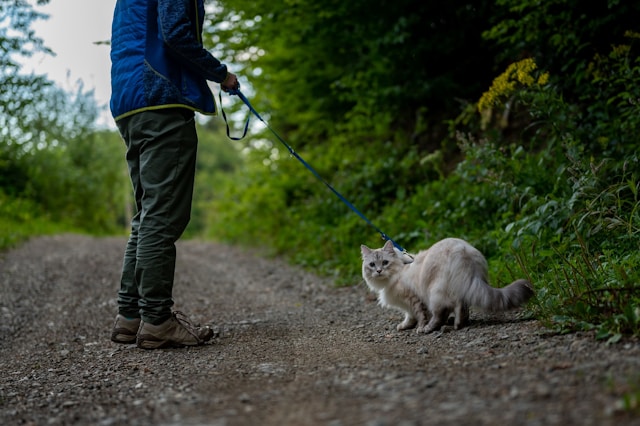
How to Train a Cat to Walk on a Leash
Taking your cat for a walk might sound unusual to some, but leash training is becoming increasingly popular among cat owners—and for good reason. Walking your cat outdoors offers mental stimulation, physical exercise, and a deeper bond between pet and owner. However, leash training a cat is very different from walking a dog, and it requires patience, the right gear, and a slow, steady approach.
In this article, we’ll walk you through step-by-step how to train your cat to walk on a leash safely and confidently.
1. Choose the Right Gear
Harness First, Leash Second
Cats can easily slip out of collars, so a well-fitting harness is essential. Look for:
- A vest-style harness or an H-harness designed specifically for cats
- Adjustable straps for a snug but comfortable fit
- Lightweight and breathable material
Leash Tips
- Start with a 4 to 6-foot lightweight leash
- Avoid retractable leashes—they can cause injury and offer less control
2. Get Your Cat Comfortable Indoors
Before you even think about heading outside, help your cat get used to wearing the harness indoors.
Step-by-Step Process:
- Let Them Sniff It: Lay the harness near your cat’s favorite spots to let them get used to its scent.
- Practice Wearing: Gently put the harness on your cat for short periods—just a few minutes at first.
- Positive Reinforcement: Offer treats, praise, or playtime while they wear it to build positive associations.
- Build Up Time: Gradually increase how long your cat wears the harness, making sure they remain comfortable.
Only once your cat is walking around confidently indoors with the harness on should you attach the leash.
3. Introduce the Leash Indoors
Once your cat is relaxed in the harness:
- Clip the leash on and let it drag behind while your cat walks freely.
- Supervise closely to ensure the leash doesn’t get caught on furniture.
- Then, hold the leash gently, letting your cat lead. Don’t tug or try to control their movement.
This helps your cat associate the leash with freedom, not restriction.
4. Take It Outside—Slowly
Choose a Safe, Quiet Spot
Start in a secure area like:
- A backyard
- A patio
- A quiet corner of a park
Avoid noisy or highly active environments that could frighten your cat.
Keep Initial Outings Short
- 5 to 10 minutes is enough at first.
- Let your cat explore at their own pace.
- Always carry a towel or carrier in case they get scared and need to be taken home quickly.
5. Watch Their Body Language
Your cat will tell you how they feel:
- Ears forward, tail up = curious and happy
- Crouching, flattened ears, or puffed tail = scared or overwhelmed
If they show signs of distress, return indoors and try again another day.
6. Consistency and Patience Are Key
Cats aren’t naturally inclined to walk with humans. It may take days—or even weeks—for your cat to become comfortable outdoors.
- Train daily if possible, but keep sessions short.
- Stay calm and encouraging.
- Never force your cat to walk or go in a direction they resist.
7. Stay Safe During Walks
- Avoid areas with dogs or heavy foot traffic.
- Don’t allow your cat to chew or eat plants—many outdoor plants are toxic.
- Keep vaccinations and flea prevention up to date.
Photo by Piotr Musioł on Unsplash
